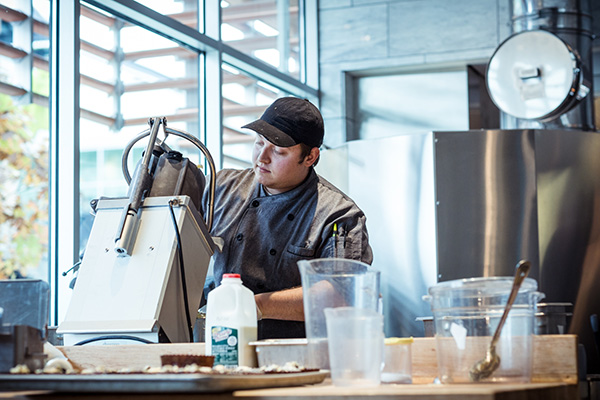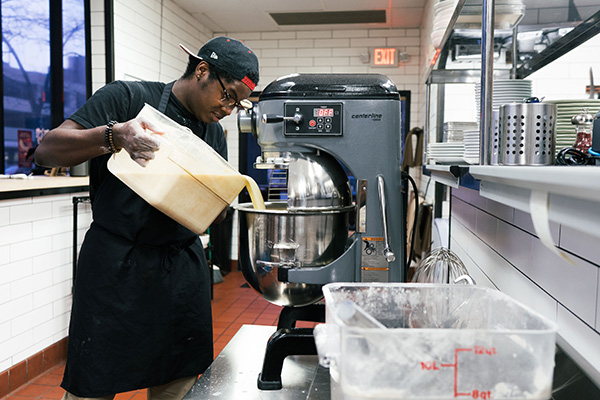Simplifying Food Prep with the Right Equipment

Whatever specialties a restaurant has, it takes time to develop the menu, source ingredients and manage labor for preparing dishes for guests. Prepping menu items can be especially time consuming when done manually, even when chefs and staff have the best skill sets. Equipment like mixers and food processors can help simplify food prep and make quick work of the job.
When looking at food prep equipment for a restaurant, there are several factors to consider. First, look for equipment with easy-to-use features since these can help expedite training, even among staff members with less experience. Also, manufacturers offer valuable resources to help make the most of their food prep equipment offering. Brochures, spec sheets and operating manuals are all helpful for understanding the proper use of a piece of equipment. How-to videos are also a great resource to see hands-on instructions for operating mixers and food processors correctly and efficiently.
When investing in food prep equipment, find machines that offer versatility to help simplify kitchen operations.
Mixing it Up
Chefs and their staff can simplify preparation of both sweet and savory ingredients with a planetary mixer. This equipment can be used for mixing dough for breads or pastries, sauces, meats for sausages or meatballs and more - and it is significantly more efficient than hand mixing. Mid-tier mixers are available in the marketplace to fit the budgets of independent restaurants that have limited mixing needs throughout the day.
The aim when mixing ingredients is to maintain consistency, which can be difficult when multiple employees operate a mixer. It's important, however, to avoid mistakes that result in downtime for scrapping ingredients and starting over. One employee may overmix dough, for example, and alter its quality. Having a mixer with digital timer can prevent this issue. The operator sets the timer to count down for an existing recipe to guarantee the appropriate mixing time. Timers can also make recipe creation easier by counting up to determine how long the new recipe should be mixed.
Understanding the which agitator to use is another important way to simplify the mixing of ingredients and gain the best quality.
Use a flat beater for mixing mashed potatoes and batters, starting with slow speed and increasing for finishing. This beater evenly distributes the ingredients, so the result is smooth output. A wing whip, used at higher speeds, is good for whipping cream and beating egg whites or light icings. For creaming butter or mixing mayonnaise, a wire whip offers efficient mixing. Slower speeds are good for heavier ingredients and faster ones are better for light ingredients. If the restaurant offers bread or pizza and needs to mix dough, a spiral or C-shaped dough hook is up for the job. These mix, stretch and fold the dough. The speed depends on the specific ingredients; however, manufacturers typically offer charts with recommendations.
Kitchens can further simplify food preparation with the addition of a vegetable slicer or meat grinder to a planetary mixer.
Consistency and Versatility
Another means to simplify food prep is by using a continuous-feed food processor. This equipment provides consistent processing of fruits, vegetables, cheeses and nuts, and is capable of slicing, dicing, shredding, grating and more. Having one machine that provides the versatility to prep multiple ingredients helps kitchen operate more efficiently.
A continuous-feed food processor is significantly faster than manually cutting ingredients, too. Smaller continuous-feed food processors can process around 11 pounds a minute, whereas large models can process up to 132 pounds a minute. This speed is especially helpful for kitchens that may be facing labor shortage. They can make the most of the available labor and free staff to take on other tasks in the kitchen.
Processing whole ingredients can improve quality, too, since they last longer than pre-packaged ingredients. That means better products for better menu items with less waste. Whole foods, like blocks of cheese, for example, are also less expensive to purchase.
As when selecting an agitator for a mixer, choosing the right blade for a continuous-feed food processor can simplify food prep. Chefs should determine what menu items they plan to prep ingredients for so that they are only purchasing the blades they need.
Slicer blades are good for processing firm and soft products, such as onions, mushrooms, cucumbers and bananas. A soft slicer works well for slicing tomatoes and can be paired with a dicing grid to dice them. Staff can use a shredder blade for shredding cabbage, cheese and carrots or add ripples to the edge of beets or cucumbers with a crimping slicer. Grater blades make it fast and easy to grate nuts and hard cheeses, along with dry bread. Some manufacturers offer chicken cutting tools for shredding chicken and French fry blades for homemade fries.

All in One Bowl
Bowl-style food processors are a good addition to kitchens looking to simplify the process of making dips, spreads and sauces. For instance, a two-speed machine consistently mixes ingredients for hummus and pesto at lower speeds and can be used for emulsifying ingredients for mayonnaise, salad dressings or Hollandaise sauce at higher speeds. Staff needs to take care, however, about the speed at which they add ingredients. For example, add oil for a vinaigrette slowly to prevent it from breaking.
Bowl-style food processors can also be used for whipping butter or chopping nuts and seeds.
Look for a bowl-style food processor with machine with a two-knife system that turns the blades in tandem. This feature helps force the ingredients into the blades to speed processing and minimize temperature increases that could negatively affect the quality of the recipe. A jog or pulse feature will also give operators more control over the consistency of the sauce, spread or chopped ingredients. The amount of time processing will determine the texture outcome.
Consider a machine with a see-through cover and built-in scraper to wipe the lid. These provide employees with visibility to what they are processing.
A Winning Combination
For kitchens that with multiple processing needs, a combination food processor can help simplify preparation of a range of ingredients. Mid-tier versions of this equipment are available in the marketplace and are a good fit for an independent restaurant.
As the name implies, combination food processors are capable of a combination of functions: both continuous-feed food processing and bowl-style processing. That allows staff to efficiently chop, dice, mince, mix and emulsify - in one machine.
When fitted with a chute head for continuous-feed processing, operators can add a slicing blade for slicing tomatoes, mushrooms and soft fruits like kiwi or banana. They can also fit the machine with a shredder bladed for efficiently shredding carrots, lettuce, potatoes or cabbage. When the bowl is in place, employees can prep the same type of menu items as with a standard bowl-style food processor: salsa, hummus, pesto, salad dressings and more.
Combination food processors are available that sense whether the chute head or bowl has been installed and adjust the processing speed accordingly.
The Results
By turning to food prep equipment like mixers and food processors, restaurants can simplify the process of prepping ingredients - saving time, labor and costs compared to manual prepping. The consistency gained from this equipment also helps produce menu items that are appealing to guests and provides the opportunity for chefs and staff to be creative with the recipes they develop.
 Carolyn Bilger is the Marketing Director for Hobart - Food Preparation Products. She has been with Hobart since 2015 and sets the strategy for marketing and new product development for the full line of Hobart food preparation equipment.
Carolyn Bilger is the Marketing Director for Hobart - Food Preparation Products. She has been with Hobart since 2015 and sets the strategy for marketing and new product development for the full line of Hobart food preparation equipment.